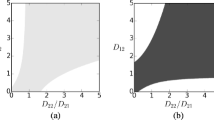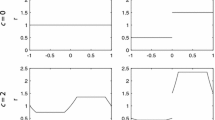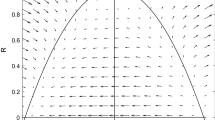Abstract
Local interactions among individual members of a population can generate intricate small-scale spatial structure, which can strongly influence population dynamics. The two-way interplay between local interactions and population dynamics is well understood in the relatively simple case where the population occupies a fixed domain with a uniform average density. However, the situation where the average population density is spatially varying is less well understood. This situation includes ecologically important scenarios such as species invasions, range shifts, and moving population fronts. Here, we investigate the dynamics of the spatial stochastic logistic model in a scenario where an initially confined population subsequently invades new, previously unoccupied territory. This simple model combines density-independent proliferation with dispersal, and density-dependent mortality via competition with other members of the population. We show that, depending on the spatial scales of dispersal and competition, either a clustered or a regular spatial structure develops over time within the invading population. In the short-range dispersal case, the invasion speed is significantly lower than standard predictions of the mean-field model. We conclude that mean-field models, even when they account for non-local processes such as dispersal and competition, can give misleading predictions for the speed of a moving invasion front.





Similar content being viewed by others
References
Adams T, Holland EP, Law R, Plank MJ, Raghib M (2013) On the growth of locally interacting plants: differential equations for the dynamics of spatial moments. Ecology 94:2732–2743
Binny RN, Haridas P, James A, Law R, Simpson MJ, Plank MJ (2016a) Spatial structure arising from neighbour-dependent bias in collective cell movement. PeerJ 4:e1689
Binny RN, James A, Plank MJ (2016b) Collective cell behaviour with neighbour-dependent proliferation, death and directional bias. Bull Math Biol 78(11):2277–2301
Binny RN, Law R, James A, Plank MJ (2019) Living in groups: spatial-moment dynamics with neighbour-biased movements. Ecological Modelling, in press
Binny RN, Plank MJ, James A (2015) Spatial moment dynamics for collective cell movement incorporating a neighbour-dependent directional bias. J R Soc Interface 12:20150228
Bolker B, Pacala SW (1997) Using moment equations to understand stochastically driven spatial pattern formation in ecological systems. Theor Popul Biol 52(3):179–197
Bolker BM, Pacala SW (1999) Spatial moment equations for plant competition: understanding spatial strategies and the advantages of short dispersal. Am Nat 153(6):575–602
Dieckmann U, Law R (2000) Relaxation projections and the method of moments. In: Dieckmann U, Law R, Metz JAJ (eds) The geometry of ecological interactions: simplifying spatial complexity. Cambridge University Press, Cambridge, pp 412–455
Dieckmann U, Law R, Metz JAJ (2000) The geometry of ecological interactions: Simplifying spatial complexity. Cambridge University Press, Cambridge
Ellner SP, Sasaki A, Haraguchi Y, Matsuda H (1998) Speed of invasion in lattice population models: pair-edge approximation. J Math Biol 36(5):469–484
Fernando AE, Landman KA, Simpson MJ (2010) Nonlinear diffusion and exclusion processes with contact interactions. Phys Rev E 81(1):011903
Godsoe W, Murray R, Plank MJ (2014) Information on biotic interactions improves transferability of distribution models. Am Nat 185(2):281–290
Hastings A, Cuddington K, Davies KF, Dugaw CJ, Elmendorf S, Freestone A, Harrison S, Holland M, Lambrinos J, Malvadkar U et al (2005) The spatial spread of invasions: new developments in theory and evidence. Ecol Lett 8(1):91–101
Hurford A, Cobbold CA, Molnár PK (2019) Skewed temperature dependence affects range and abundance in a warming world. Proc R Soc B 286:20191157
Johnston ST, Simpson MJ, Plank MJ (2013) Lattice-free descriptions of collective motion with crowding and adhesion. Phys Rev E 88(6):062720
Katul GG, Porporato A, Nathan R, Siqueira M, Soons MB, Poggi D, Horn HS, Levin SA (2005) Mechanistic analytical models for long-distance seed dispersal by wind. Am Nat 166(3):368–381
Kot M, Lewis MA, van den Driessche P (1996) Dispersal data and the spread of invading organisms. Ecology 77(7):2027–2042
Law R, Murrell DJ, Dieckmann U (2003) Population growth in space and time: Spatial logistic equations. Ecology 84(1):252–262
Lewis MA (2000) Spread rate for a nonlinear stochastic invasion. J Math Biol 41(5):430–454
Lewis MA, Pacala S (2000) Modeling and analysis of stochastic invasion processes. J Math Biol 41 (5):387–429
Mahdi A, Law R (1987) On the spatial organization of plant species in a limestone grassland community. J Ecol 75:459–476
Maini PK, McElwain DLS, Leavesley DI (2004) Traveling wave model to interpret a wound-healing cell migration assay for human peritoneal mesothelial cells. Tissue Eng 10(3-4):475–482
Murrell DJ (2005) Local spatial structure and predator-prey dynamics: counterintuitive effects of prey enrichment. Am Nat 166:354–367
Murrell DJ, Dieckmann U, Law R (2004) On moment closures for population dynamics in continuous space. J Theor Biol 229(3):421–432
Murrell DJ, Law R (2000) Beetles in fragmented woodlands: A formal framework for dynamics of movement in ecological landscapes. J Anim Ecol 69(3):471–483
Murrell DJ, Law R (2003) Heteromyopia and the spatial coexistence of similar competitors. Ecol Lett 6 (1):48–59
Omelyan I, Kozitsky Y (2019) Spatially inhomogeneous population dynamics: beyond the mean field approximation. J Phys A Math Theor 52:305601
Pacala SW, Silander JA Jr (1985) Neighborhood models of plant population dynamics. I. Single-species models of annuals. Am Nat 125(3):385–411
Paradis E, Baillie SR, Sutherland WJ (2002) Modeling large-scale dispersal distances. Ecol Model 151 (2-3):279–292
Plank MJ, Law R (2015) Spatial point processes and moment dynamics in the life sciences: a parsimonious derivation and some extensions. Bull Math Biol 77(4):586–613
Plank MJ, Simpson MJ (2012) Models of collective cell behaviour with crowding effects: comparing lattice-based and lattice-free approaches. J R Soc Interface 9(76):2983–2996
Purves DW, Law R (2002) Fine-scale spatial structure in a grassland community: quantifying the plant’s-eye view. J Ecol 90:121–129
Simpson MJ, Baker RE (2011) Corrected mean-field models for spatially dependent advection-diffusion-reaction phenomena. Physical Review E 83(5):051922
Sprague R, Godsoe W, Hulme PE (2019) Assessing the utility of aerial imagery to quantify the density, age structure and spatial pattern of alien conifer invasions. Biol Invasions 21(6):2095–2106
Sundberg S (2005) Larger capsules enhance short-range spore dispersal in Sphagnum, but what happens further away? Oikos 108(1):115–124
Surendran A, Plank MJ, Simpson MJ (2018) Spatial moment description of birth–death–movement processes incorporating the effects of crowding and obstacles. Bull Math Biol 80(11):2828–2855
Yokozawa M, Kubota Y, Hara T (1999) Effects of competition mode on the spatial pattern dynamics of wave regeneration in subalpine tree stands. Ecol Model 118(1):73–86
Acknowledgments
We are grateful to Frederic Barraquand and one anonymous reviewer for critical comments on an earlier version of the manuscript.
Funding
MP and RB acknowledge financial support from Te Pūnaha Matatini. MJS is supported by the Australian Research Council (DP170100474).
Author information
Authors and Affiliations
Corresponding author
Additional information
Publisher’s note
Springer Nature remains neutral with regard to jurisdictional claims in published maps and institutional affiliations.
Rights and permissions
About this article
Cite this article
Plank, M.J., Simpson, M.J. & Binny, R.N. Small-scale spatial structure influences large-scale invasion rates. Theor Ecol 13, 277–288 (2020). https://doi.org/10.1007/s12080-020-00450-1
Received:
Accepted:
Published:
Issue Date:
DOI: https://doi.org/10.1007/s12080-020-00450-1




